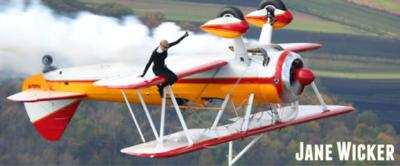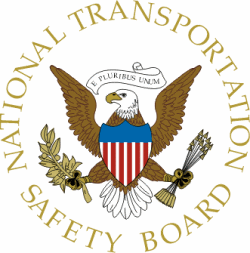Two Fatally Injured During Wing Walking Performance June 22
The NTSB has released its preliminary report from an accident June 22 in which well-known wing walker Jane Wicker and pilot Charlie Schwenker were fatally injured while performing at the Vectren Dayton Air Show. The report indicates that there were no mechanical difficulties with the Stearman reported by either Wicker or Schwenker following practice the day before the Saturday performance.

NTSB Identification: CEN13FA274
14 CFR Part 91: General Aviation
Accident occurred Saturday, June 22, 2013 in Dayton, OH
Aircraft: BOEING-STEARMAN IB75A, registration: N450JW
Injuries: 2 Fatal,2 Minor.
This is preliminary information, subject to change, and may contain errors. Any errors in this report will be corrected when the final report has been completed.
On June 22, 2013, about 1245 eastern daylight time, a Boeing-Stearman IB75A airplane, N450JW, impacted terrain at Dayton International Airport (KDAY), Dayton, Ohio. The commercial pilot and wing walker were both fatally injured. The airplane was destroyed. The airplane was registered to a private citizen and operated by Jane Wicker Airshows under the provisions of 14 Code of Federal Regulations Part 91. Visual meteorological conditions prevailed for the flight, which operated without a flight plan. The local flight was performing for the 2013 Vectren Dayton Air Show at KDAY and departed KDAY about 1235.
The air show airspace was orientated along runway 6L/24R. The performance was the fourth act scheduled on June 22.
Video and photos submitted by spectators captured the airplane during the performance and accident. A review of the photography showed the airplane completed a left “tear drop” style turn, positioning to cross in front of the spectators from the left. The wing walker had positioned herself on the bottom side of the lower left wing. As the airplane approached the crowd, it rolled upside down. While flying inverted from the southeast to the northwest in front of the spectators, the airplane’s nose pitched slightly above the horizon. The airplane abruptly rolled to the right and impacted terrain in a descending left-wing-low attitude. A postimpact fire ensued and consumed a majority of the right wing and forward portion of the fuselage.

The accident site was a grass area south of the intersection of taxiway R and taxiway Z. The debris field followed a 050 degree heading and was about 145 feet long. The first ground scars were two parallel scars, consistent with the left wing’s impact. The impact crater, which was 11 feet long, 6 feet wide, and at least 13 inches deep, was located about 40 feet from the beginning of the ground scars. The main wreckage came to rest 105 feet from the impact crater. All flight controls were accounted for at the accident site. The wreckage was documented and transported to a secure location for further examination.
Initial statements gathered by the NTSB and FAA indicated that the pilot and wing walker had practiced the performance the day before the accident. Following the practice, neither the pilot nor the pilot-rated wing walker, reported any mechanical malfunctions or failures with the airplane.
At the time of the accident, wind was recorded from 220 degrees at 10 knots, visibility at 9 miles, a broken ceiling at 3,500 feet, temperature of 86 degrees Fahrenheit (F), dew point of 72 F, and barometric pressure of 30.18 inches of mercury.
 Senator Pushes FAA to Accelerate Rocket Launch Licensing
Senator Pushes FAA to Accelerate Rocket Launch Licensing Classic Aero-TV: RJ Gritter - Part of Aviations Bright New Future
Classic Aero-TV: RJ Gritter - Part of Aviations Bright New Future Aero-FAQ: Dave Juwel's Aviation Marketing Stories -- ITBOA BNITBOB
Aero-FAQ: Dave Juwel's Aviation Marketing Stories -- ITBOA BNITBOB ANN's Daily Aero-Linx (10.27.24)
ANN's Daily Aero-Linx (10.27.24) ANN's Daily Aero-Term (10.27.24): Clearance Void If Not Off By (Time)
ANN's Daily Aero-Term (10.27.24): Clearance Void If Not Off By (Time)




